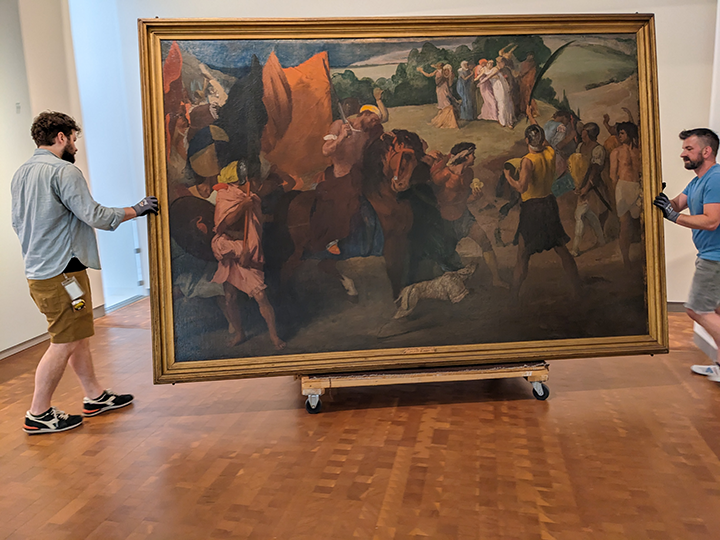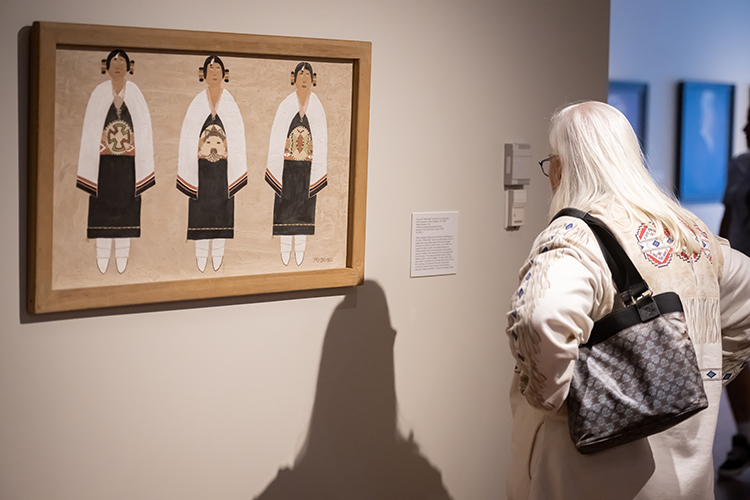collections care
artwork movement

Several large construction projects at the museum kept the collections management team busy moving thousands of objects around the building. The renovation of the Cunningham Center for the Study of Prints, Drawings and Photographs, a project funded by Jan Fullgraf Golann ’71 and Joan Williams Rhame ’49 to increase the museum’s storage capacity for works on paper, was completed in early 2023. For the duration of the project, the collection of more than 24,000 works on paper was temporarily relocated to other art storage areas in the building. In order to accommodate this move, several storage rooms were reconfigured, and non-artwork material in storage—including crates, casework and exhibition furniture—was temporarily relocated off-site.
Not long after the works on paper returned to the Cunningham Center, the museum embarked on a roof renovation project, necessary to bring the building’s fireproofing up to code and to resolve several persistent roof leaks. As the repairs were taking place directly above the third-floor galleries, all of the artwork on that floor was removed from view, returning more than 200 paintings, sculptures and works on paper to art storage. Fortunately, through careful reconfiguration of the permanent collection storage areas and by utilizing the space freed up by the return of works on paper to the Cunningham Center, all of the deinstalled works were able to be safely stored on-site and will remain in storage until the reinstallation of the third-floor galleries.
Although moving so many objects was logistically challenging, the end result of expanded and improved facilities for storage and teaching was more than worth it. A somewhat less visible but no less important additional benefit is that the movement of objects provided an opportunity to inventory a large portion of the collection to ensure that the collections management database system is up-to-date.
language improvement
The museum is continuing its work to use more inclusive and culturally appropriate language to describe objects in the collection and to make improvements in how we catalogue and display artwork. In 2022, Isabel Cordova ’19 and Sydney Nguyen, SCMA’s Five College Post-Baccalaureate Assistants for Indigenous American Collections, curated an installation in the third-floor galleries that examined the colonial pathways that brought Native American objects to museum collections. Gallery labels explored issues of terminology, reflecting the work done by the curators throughout their fellowship.
In 2023, the Museum Collections Leadership Council (MCLC)—comprising the museum directors of the Smith College Museum of Art, Mount Holyoke Art Museum, Mead Art Museum at Amherst College, Hampshire College Art Gallery, The University Museum of Contemporary Art at University of Massachusetts Amherst, and Historic Deerfield—was awarded a two-year, $350,000 grant from the National Endowment for the Humanities to make critical improvements to their shared collections management system. This database has been a collaborative endeavor since its implementation in the 1990s, and collections staff at member institutions are actively working on standardizing existing data in preparation for moving to a new database platform. Over the course of the NEH grant, through the development of a cultural advisory council and the work of a cataloging metadata librarian, the consortium will receive feedback and direction on its data standards and language use. This feedback will be used to clean and enhance existing database records and to develop new standards for entering data with culturally appropriate language.

top to bottom: Preparator Matthew Cummings and Chief Preparator Nikolas Asikis move an artwork during the third-floor renovation. Photo by Kelly Holbert; Visitor looking closely at a work or art in the Colonial Entanglements installation. Photo by Derek Fowles Photography